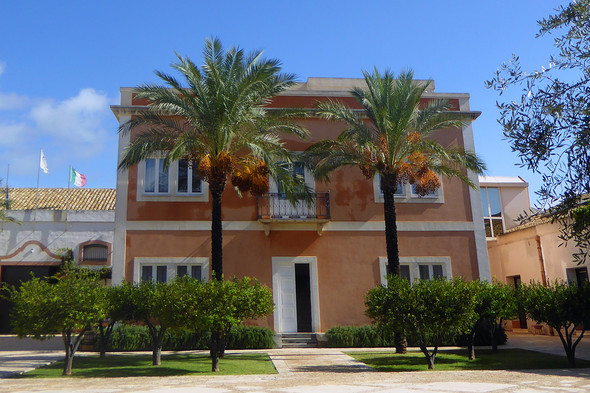Antonio and José, are the fifth generation of the Rallo family, making wine in Sicily since 1851, when their Marsala cellars were built, although the brand name Donnafugata itself only dates from 1983. José explained that this name, logo of a woman’s head with windblown hair and mission personified her mother, escaping her past as a schoolteacher, when she inherited the vineyard. Although their website paints a different picture, as a tribute to Sicilian history. In this case, the ‘donna fugata’, the woman in flight, is Queen Maria Carolina, wife of Ferdinand IV of Bourbon who fled Napoleon’s troops when they took Naples, seeking refuge in Sicily. Giuseppe Tomasi di Lampedusa, author of ‘Il Gattopardo’, The Leopard, gave this name to the country estate of the Prince of Salina, where the queen stayed and which now holds some of the family’s vineyards. The literary theme is also continued in ‘Tancredi’, their Nero d’Avola and Cabernet Sauvignon blend. Tancredi was the revolutionary hero of the above novel, obligatory reading for those who want to learn something about Sicilian history.
In the past in Sicily, the philosophy was to grub up vines that don’t produce lots of grapes. This led to a decline in quality and the near loss of traditional varieties. Donnafugata’s philosophy is quite the opposite, to select vines producing less and grub up the others, to focus on the cluster, climate, terroir and vintage. When the neighbours observed what they were doing, the Rallos were asked accusingly, ‘Does your grandfather know what you’re doing?’
The cellars in Marsala, still retaining their original ‘baglio’ (fortified manor house) layout with citrus and olive trees, are their strategic base. However, they also have vineyards in Contessa Entellina and on Pantelleria, where the vines are more than 100 years old. Here the vines are dug into holes to protect them from the fierce Sirocco wind. This is where their luscious passito Bem ryè originates. Made from Zibibbo grapes (aka Muscat of Alessandria), the grapes are cut as for a green harvest and dried on nets or in greenhouses for 20 days. Before fermentation, the grapes are then added to fresh grape must, which enables them to maintain a balance between fresh acidity and the sweet, concentrated passito grapes.
They are also participating in a regional project, planting 19 different autochthonous varieties, including some almost extinct varieties, such as Alzano, Nocera and Vitrarolo, along with clones of more familiar varieties such as Nero d’Avola and Catarratto. They hope it will be possible to try the wines from some of these in ten years or so.
In addition to their literary connections, there is also a musical element – the Donnafugata Music&Wine Live project, pairing wine and jazz in a multi-sensorial experience, with the proceeds going to help the Palermo City Hospital. The singer is none other than José, who also broke into song with a rendition of a Sicilian folk song during our tasting!






